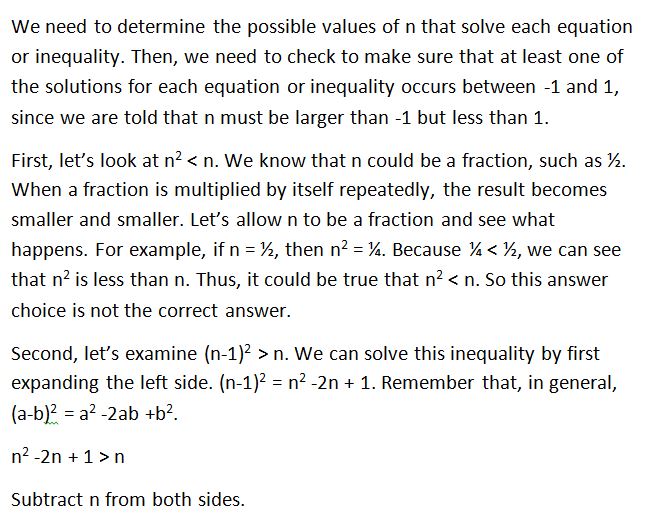All GRE Math Resources
Example Questions
Example Question #1 : How To Find The Solution To An Inequality With Multiplication
Quantitative Comparison
Column A: 
Column B:
Quantity A is greater.
The relationship cannot be determined from the information provided.
The quantities are equal.
Quantity B is greater.
The relationship cannot be determined from the information provided.
For quantitative comparison questions involving a shared variable between quantities, the best approach is to test a positive integer, a negative integer, and a fraction. Half of our work is eliminated, however, because the question stipulates that x > 0. We only need to check a positive integer and a positive fraction between 0 and 1. Plugging in 2, we see that quantity A is greater than quantity B. Checking 1/2, however, we find that quantity B is greater than quantity A. Thus the relationship cannot be determined.
Example Question #1 : How To Find The Solution To An Inequality With Multiplication
If –1 < n < 1, all of the following could be true EXCEPT:
|n2 - 1| > 1
(n-1)2 > n
16n2 - 1 = 0
n2 < n
n2 < 2n
|n2 - 1| > 1
Example Question #3 : How To Find The Solution To An Inequality With Multiplication
(√(8) / -x ) < 2. Which of the following values could be x?
-4
-1
-3
-2
All of the answers choices are valid.
-1
The equation simplifies to x > -1.41. -1 is the answer.
Example Question #22 : Inequalities
Solve for x
Example Question #23 : Inequalities
We have 
Example Question #24 : Inequalities
Fill in the circle with either 




None of the other answers are correct.
The rational expression is undefined.
Let us simplify the second expression. We know that:
So we can cancel out as follows:
Example Question #1 : How To Find The Solution To An Inequality With Multiplication
Solve the inequality 
Start by simplifying the expression by distributing through the parentheses to 
Subtract 

Next subtract 9 from both sides to get 


Example Question #1 : How To Find The Solution To An Inequality With Multiplication
Solve the inequality 
Start by simplifying each side of the inequality by distributing through the parentheses.
This gives us 
Add 6 to both sides to get 
Add 

Divide both sides by 13 to get 
All GRE Math Resources











































